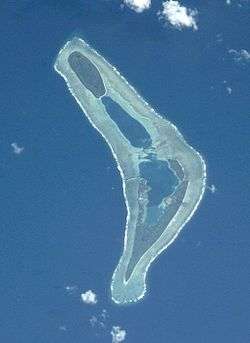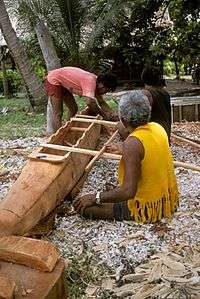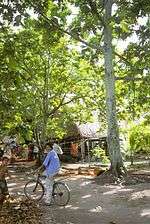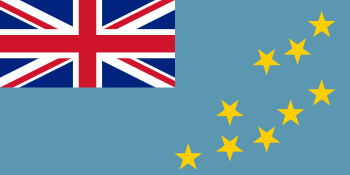Nanumea
| Nanumea | |
|---|---|
| Atoll | |
 Nanumea atoll from space | |
 Nanumea Location in Tuvalu | |
| Coordinates: 05°41′S 176°12′E / 5.683°S 176.200°ECoordinates: 05°41′S 176°12′E / 5.683°S 176.200°E | |
| Country | Tuvalu |
| Area | |
| • Total | 3.9 km2 (1.5 sq mi) |
| Population (2012) | |
| • Total | 544 |
| • Density | 140/km2 (360/sq mi) |
| ISO 3166 code | TV-NMA |
Nanumea is the northwesternmost atoll in the Polynesian nation of Tuvalu, a group of nine coral atolls and islands spread over about 400 miles (640 km) of Pacific Ocean just south of the equator and west of the International Date Line. Nanumea is 4 km sq. with a population of 544 people (2012 census).[1]
Geography
Located at along one edge of the so-called Polynesian triangle, Nanumea lies just south of the Gilbert Islands, which are Micronesian in language and culture. Nanumea is a classic atoll, a series of low islets sitting on a coral reef shelf surrounding a lagoon. About 12 kilometres (7.5 mi) long by 2.5 kilometres (1.6 mi) wide in overall size, the dry land area is about 3.9 square kilometres (1.5 sq mi).
The Nanumea Conservation Area covers about 2 square kilometres (0.77 sq mi) of the central lagoon and consists of about 10% of the reef area of the atoll, including marine habitats and 2 islets. A survey of the conservation zone was conducted in 2010.[2][3]
The larges villages are Lolua with 186 people (2012) and Haumaefa with 187 people (2012).[1] The junior school is Kaumaile Primary School. There are scattered households across the lagoon from Nanumea village at Matagi and on Motu Foliki, and on the southeastern tip of Lakena islet. The two largest islets, comprising over 90% of the dry land area of the atoll, are Nanumea and Lakena. In addition there are three much smaller islets, Motu Foliki, Lafogaki and Te Afua-a-Taepoa spread around the encircling reef flat.
The pulaka pits are located on Lakena as the Nanumeans want the main island of Nanumea to remain mosquito free. Pulaka is grown in large pits of composted soil below the water table.[4]
In March 2015 Nanumea suffered damage to houses, crops and infrastructure as the result of storm surges caused by Cyclone Pam.[5][6]
Language and cultural links
Nanumeans are Polynesians. The Nanumean dialect of the Tuvaluan language is closely related to other west Polynesian languages including Tongan language, Tokelauan, Samoan, and the languages of the Polynesian outliers. Although the eight Tuvalu communities have distinctive accents and some distinctive vocabulary, the dialects of Tuvalu are mutually intelligible to Tuvalu speakers with the exception of the language of Nui atoll, whose inhabitants speak a dialect of the Gilbertese language (with the exception of small children, most Tuvaluans from Nui also speak Tuvaluan). With this exception, Tuvaluan is universally understood and spoken in Tuvalu. English is also spoken, especially in Tuvalu's capital, and is one of the official languages of the central government.
History

The rich mythical history of Nanumea describes settlement led by an explorer/adventurer and warrior from the south named Tefolaha. Some accounts say Tefolaha and his crew came from Tonga, others name Samoa, but whether these names refer to today's Tonga and Samoa is not certain. Tefolaha, traditional accounts say, found the island of Nanumea populated by two women, Pai and Vau, whom it was believed had formed it from baskets of sand. Tefolaha wagered with them for the island and eventually won it through trickery, whereupon Pai and Vau departed.[7] Tefolaha's sons and daughters are today the founding ancestors of leading families and the seven chiefly lineages of Nanumea. Today's population also traces descent from crew members who arrived with Tefolaha, and from later visitors from the far distant and more recent past. Nanumean traditions describe the islets, Motu Foliki, Lafogaki and Te Afua-a-Taepoa, as being formed when sand spilled from the baskets of two women, Pai and Vau, when they were forced off Nanumea by Tefolaha.[8]
The legendary, miraculous spear Kaumaile came with the hero Tefolaha on the South Pacific island Nanumea. He fought with about 1.80 meters long weapon on the islands of Samoa and Tonga. As Tefolaha died, went "Kaumaile" to his heirs, then to his heirs and on and on - 23 generations. It's about 880 years old and the tree was cut on Samoa.[9]
First recorded sighting by Europeans of Nanumea was by Spanish naval officer Francisco Mourelle de la Rúa who sailed past it on 5 May 1781 with frigate La Princesa, when attempting a southern crossing of the Pacific from the Philippines to New Spain. He charted Nanumea as San Augustin.[10][11] In 1809 Captain Patterson in the brig Elizabeth sighted Nanumea while passing through the northern Tuvalu waters on a trading voyage from Port Jackson, Sydney, Australia to China.[10]
From 1879 to 1881 Alfred Restieaux was the resident trader on Nanumea.[12][13] 19th century resident Palagi traders also included: Tom Day (c.1872)[14] and Jack Buckland (c.1895). The population of Nanumea from 1860-1900 is estimated to be between 500[15] and 650 people.[16]
Nanumea Post Office opened around 1919.[17]
During World War II the American forces build Nanumea Airfield and the people moved to live on Lakena.[18] USS LST-203 was grounded on the reef at Nanumea on 2 October 1943 in order to land equipment. The rusting hull of the ship remains on the reef.[19] The 'American Passage' was blasted through the reef by a Naval Construction Battalion (Seabees), who were assisted by local divers. This passage improved access to Nanumea. B-24 Liberator aircraft of 30th Bombardment Group flew from Nanumea Airfield. After the war the airfield was dismantled and the land returned to its owners, however as the coral base was compacted to make the runway the land now provides poor ground for growing coconuts.[18]
Governance and connection to other Nanumean communities
Nanumea's local government consists of a chiefly council (Falekaupule) representing the seven chiefly lines which trace descent from the founder, Tefolaha, or from other key settlers, and an elected high chief (Pulefenua). The island also elects and sends two representatives to the Tuvalu national parliament based in the capital, Funafuti.
While Nanumea atoll remains the homeland for all Nanumeans, there are increasingly large populations of Nanumeans resident in the capital, Funafuti, in New Zealand (especially Auckland and Wellington), and in Australia and other Pacific locations. These expatriate populations are well-organized, have active elected leadership councils, and keep in close touch with doings in Nanumea itself.
General election, 2015
The Tuvaluan general election, 2015 was held on 31 March. Maatia Toafa and Satini Manuella were returned to parliament.[20][21]
| Party | Candidate | Votes | % | |
|---|---|---|---|---|
| Non-partisan | Maatia Toafa |
515 | 33 | |
| Non-partisan | Satini Manuella |
524 | 33.3 | |
| Non-partisan | David Manuvasa Manuella | 273 | 17 | |
| Non-partisan | Hilia Vavae | 229 | 14.5 | |
| Non-partisan | Kata Pulusi | 36 | 2.3 | |
Identity

Nanumean identity and pride is demonstrated in many ways, from the distinctive intonation pattern and vocabulary of its version of Tuvaluan to celebrations including its unique Po o Tefolaha, part of a long holiday covering Christmas, New Year and some weeks beyond. These "Big Days" (Po Lahi) celebrations, marked with noon feasts in the island's community hall, the Ahiga, feature a marathon round of the competitive ball game Ano, pitting the two village sides, Haumaefa and Lolua, against each other. On 8 January each year, the island's conversion to Christianity over a century ago is commemorated in the Po o Tefolaha, Tefolaha's Day. Po Lahi is celebrated in Nanumea itself and by many Nanumean communities overseas, including those in Funafuti, Fiji, Auckland (NZ), Wellington (NZ), Tarawa, Australia and other locations.
A widely recognized symbol of Nanumean identity and unity is the fighting spear, "Kaumaile."[22][23] Said to have been brought with him by the island's founder, Tefolaha, Kaumaile was used to defeat invaders to Nanumea, most notably by Lapi to defeat a giant, Tuulaapoupou.[24] Recent carbon dating tests have shown that the Kaumaile spear is over 800 years old.[25]
Prominent local people
Maatia Toafa, Prime Minister of Tuvalu 2004–2006 and continues to represent Nanumea in the Parliament of Tuvalu. On 5 August 2013 Maatia Toafa was appointed the Minister of Finance and Economic Development in the government led by Enele Sopoaga.[26]
Willy Telavi was first elected to parliament in 2006 and was appointed Home Affairs Minister in the Government of Apisai Ielemia. He was re-elected in 2010 and became the Prime Minister of Tuvalu on 24 December 2010. His term of prime minister ended on 2 August 2013 following the vote on a motion of no confidence.[27] He resigned from Parliament in August 2014.[28][29]
Lady Naama Maheu Latasi, the first woman to be elected to the Parliament of Tuvalu, was elected from the constituency of Nanumea.[30]
References
- 1 2 "Population of communities in Tuvalu". Thomas Brinkhoff. 11 April 2012. Retrieved 20 March 2016.
- ↑ Sandrine Job, Dr. Daniela Ceccarelli (December 2012). "Tuvalu Marine Life Scientific Report" (PDF). an Alofa Tuvalu project with the Tuvalu Fisheries Department. Retrieved 3 December 2013.
- ↑ Sandrine Job, Dr. Daniela Ceccarelli (December 2011). "Tuvalu Marine Life Synthesis Report" (PDF). an Alofa Tuvalu project with the Tuvalu Fisheries Department. Retrieved 3 December 2013.
- ↑ Taulu Isako, Hugh Laracy (ed.) (1983). "Chapter 7 – Nanumea". Tuvalu: A History. Institute of Pacific Studies, University of the South Pacific and Government of Tuvalu. pp. 55–56.
- ↑ "Tuvalu: Tropical Cyclone Pam Situation Report No. 2 (as of 30 March 2015)". Relief Web. 30 March 2015. Retrieved 30 March 2015.
- ↑ "Tuvalu situation update: Securing health from disastrous impacts of cyclone Pam in Tuvalu". Relief Web/World health Organisation – Western Pacific Region. 3 April 2015. Retrieved 8 June 2015.
- ↑ Samuels, George Siosi. "Tales From Nanumea: Pai & Vau (Animation)". The Loop. Retrieved 15 February 2015.
- ↑ Taulu Isako, Hugh Laracy (ed.) (1983). "Chapter 7 – Nanumea". Tuvalu: A History. Institute of Pacific Studies, University of the South Pacific and Government of Tuvalu. p. 49.
- ↑ http://www.spiegel.de/wissenschaft/mensch/suedsee-speer-hamburger-forscher-bestimmt-holzart-a-971945.html
- 1 2 Keith S. Chambers & Doug Munro, The Mystery of Gran Cocal: European Discovery and Mis-Discovery in Tuvalu, 89(2) (1980) The Journal of the Polynesian Society, 167-198
- ↑ Laumua Kofe, Palagi and Pastors, Tuvalu: A History, Ch. 15, (USP / Tuvalu government)
- ↑ Resture, Alfred. "Alfred Restieaux Manuscripts – Part 2". Jane Resture. Retrieved 23 March 2013.
- ↑ Munro, Doug (1980). "Tom De Wolf's Pacific Venture: The Life History of a Commercial Enterprise in Samoa". Retrieved 23 March 2013.
- ↑ Hayter, Lieut, Francis, Logbook & Journal, H.M.S. Basilisk, January 1871-1873, Pacific Manuscripts Bureau
- ↑ Richard Bedford, Barrie Macdonald & Doug Monro, Population Estimates for Kiribati and Tuvalu (1980) 89(1) J. of the Polynesian Society 199
- ↑ W.F. Newton, The Early Population of the Ellice Islands, 76(2) (1967) The Journal of the Polynesian Society, 197-204.
- ↑ Premier Postal History. "Post Office List". Premier Postal Auctions. Retrieved 5 July 2013.
- 1 2 Melei Telavi, Hugh Laracy (ed.) (1983). "Chapter 18 - War". Tuvalu: A History. Institute of Pacific Studies, University of the South Pacific and Government of Tuvalu. p. 143.
- ↑ Bartsch, Bill. "War Relics in Tuvalu and Kiribati" (PDF). South Pacific Bulletin (1975). Retrieved 7 April 2014.
- ↑ "Election looks set to return Sopoaga as Tuvalu's PM". Radio New Zealand. 2 April 2015. Retrieved 2 April 2015.
- ↑ "Tuvalu National Election 2015 Results (Nanumea)". Fenui News. 1 April 2015. Retrieved 1 April 2015.
- ↑ Chambers, Keith S.; Chambers, Anne (2001). Unity of Heart: Culture and Change in a Polynesian Atoll Society. Prospect Hts, Illinois: Waveland Press. ISBN 1-57766-166-4.
- ↑ More about the Kaumaile
- ↑ Samuels, George Siosi. "Tales From Nanumea: The Defeat of Tulaapoupou (Animation)". The Loop. Retrieved 15 February 2015.
- ↑ Nanumea Website
- ↑ "Enele Sopoaga Sworn-in Today as Tuvalu's New PM". Islands Business. 5 August 2013. Retrieved 5 August 2013.
- ↑ Cooney, Campbell (4 August 2013). "Tuvalu parliament elects new prime minister". Australia News Network. Retrieved 5 August 2013.
- ↑ "Former Tuvalu PM quits parliament". Radio New Zealand International. 26 August 2014. Retrieved 26 August 2014.
- ↑ "Tuvalu to hold by-election after MP resignation". Radio Australia. 25 August 2014. Retrieved 26 August 2014.
- ↑ "The first elected female Member of Parliament in Tuvalu, Lady Sapeta Naama Maheu Laatasi, laid to rest in Funafuti" (PDF). Tuvalu Philatelic Bureau Newsletter (TPB: 01/2012). 2 May 2012.
Literature
Chambers, Keith S. and Anne 2001 Unity of Heart: Culture and Change in a Polynesian Atoll Society. Prospect Hts, Illinois: Waveland Press (ISBN 1-57766-166-4)
Chambers, Anne 1984 Nanumea. (No. 6 in Atoll Economy: Social Change in Kiribati and Tuvalu.) Canberra: Australian National University, Development Studies Centre (ISBN 0-86784-457-4)
Chambers, Keith S. 1984 Heirs of Tefolaha: Tradition and Social Organization in Nanumea, a Polynesian Atoll Community. Ph.D. Dissertation, Anthropology, University of California, Berkeley (pub. by University Microfilms, Ann Arbor, Michigan)
Laracy, Hugh (editor) 1983 Tuvalu: a History. Suva: University of the South Pacific, Institute of Pacific Studies and Extension Services, and Funafuti: Ministry of Social Services. [21 chapters, maps, photos, appendices. Chapters written by Tuvaluan authors]
External links
- TALES FROM NANUMEA: PAI & VAU, animation by George Siosi Samuels, Cultural Animator
- TALES FROM NANUMEA: THE DEFEAT OF TULAAPOUPOU, animation by George Siosi Samuels, Cultural Animator
- Nanumea.Net—A Website for the People of Nanumea
- Images and further information on the Kaumaile spear from Nanumea.net
- TuvaluIslands.com
